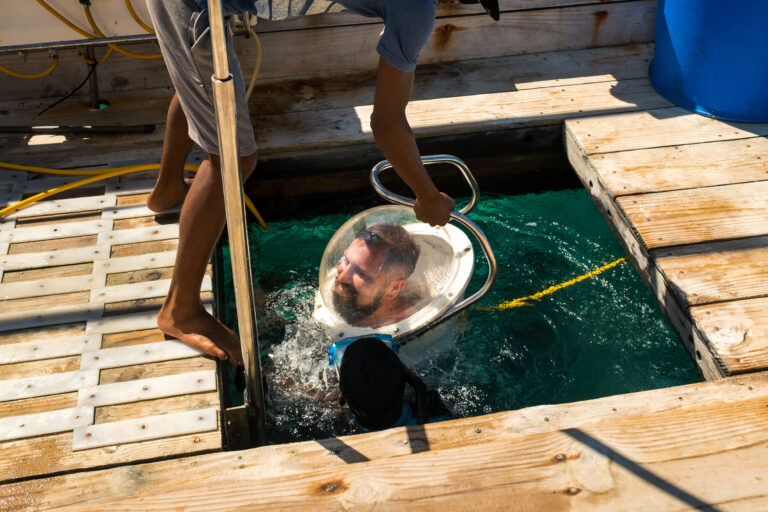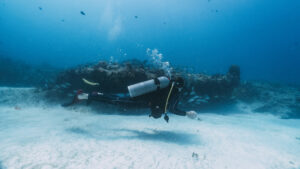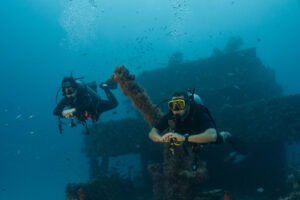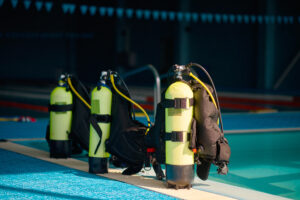What is a Pre-fill External Inspection?
A pre-fill external inspection is a crucial safety procedure conducted before refilling a scuba tank with air or other breathing gases. This inspection ensures that the scuba tank and its components are in optimal condition, preventing potential hazards during a dive. By meticulously examining the external aspects of the tank, divers and professionals can identify and rectify issues that might compromise safety. This article delves into the various aspects of pre-fill external inspections, highlighting their importance, the standards governing them, the inspection process, and common issues detected.
Purpose of Pre-fill External Inspections
The primary purpose of a pre-fill external inspection is to ensure the safety and integrity of scuba diving equipment. Scuba tanks, like all critical gear, are subject to wear and tear over time. Without proper inspection, minor issues can escalate into major problems, potentially leading to equipment failure underwater. Conducting a thorough inspection before each fill helps prevent accidents and ensures that the equipment performs as expected.
Another essential objective of pre-fill inspections is to maintain compliance with safety standards and regulations. Diving organizations and regulatory bodies set stringent guidelines to ensure diver safety. Regular inspections help meet these requirements, providing peace of mind to divers and professionals alike. This proactive approach to equipment maintenance not only safeguards the diver but also extends the lifespan of the equipment.
In addition to safety and compliance, pre-fill external inspections also serve to instill confidence in divers. Knowing that their equipment has been rigorously checked and deemed safe to use enhances their overall diving experience. This practice underscores the importance of safety in scuba diving, fostering a culture of responsibility and vigilance among divers and professionals.
Regulatory and Safety Standards
Several regulatory and safety standards govern the practice of pre-fill external inspections in scuba diving. Organizations such as PADI (Professional Association of Diving Instructors), NAUI (National Association of Underwater Instructors), and BSAC (British Sub-Aqua Club) provide comprehensive guidelines on conducting these inspections. These standards emphasize the critical nature of regular equipment checks to ensure diver safety.
International standards also play a significant role in shaping inspection protocols. The International Organization for Standardization (ISO) has developed guidelines that outline the requirements for the inspection and testing of gas cylinders. These standards ensure a consistent approach to safety, regardless of geographic location. Similarly, European norms and regulations provide detailed instructions on the maintenance and inspection of scuba tanks, aligning with broader safety objectives.
Compliance with these standards is not optional but mandatory for diving operations. Failure to adhere to these guidelines can result in severe consequences, including legal penalties and increased risk of accidents. By following these standards, dive centers, professionals, and divers can ensure that their equipment is safe, reliable, and ready for use. This adherence to regulations also reinforces the importance of safety in the diving community, promoting best practices across the board.
Components of the External Inspection
A thorough pre-fill external inspection involves a detailed examination of several components of the scuba tank. The first aspect to inspect is the cylinder body. Inspectors look for any signs of physical damage, such as dents, scratches, or corrosion. Dents can weaken the structural integrity of the cylinder, while corrosion, especially if it penetrates the metal, can compromise its strength. Any indication of damage may warrant further testing or removal of the tank from service.
The next critical component is the valve. Inspecting the valve involves checking for any signs of wear, leaks, or damage. A malfunctioning valve can lead to air leaks, which are dangerous during a dive. Inspectors also ensure that the valve operates smoothly and that the threads are not stripped or damaged. Proper valve function is crucial for maintaining the pressure and flow of breathing gases.
Cylinder markings and labels are another essential aspect of the inspection. These markings include information such as the manufacturing date, hydrostatic test date, and serial number. Inspectors verify that all required markings are present and legible. This information is vital for tracking the cylinder’s history and ensuring it meets regulatory requirements. Missing or illegible markings can lead to the rejection of the tank for filling.
The tools and techniques used in these inspections are specialized to detect even minor defects. Visual inspection tools, such as magnifying glasses and mirrors, help identify surface imperfections. Some inspectors also use ultrasonic testing equipment to detect internal flaws that may not be visible externally. By employing these tools, inspectors can provide a comprehensive assessment of the tank’s condition, ensuring its safety and reliability.
Common Issues Detected during Inspections
During pre-fill external inspections, several common issues are often detected. Corrosion is one of the most frequent problems. Scuba tanks are exposed to harsh environments, including saltwater, which can accelerate corrosion. Surface corrosion can usually be cleaned, but deep pitting corrosion is more serious and may render the tank unsafe for use. Regular inspections help catch corrosion early before it becomes a significant problem.
Physical damage, such as dents and scratches, is another common issue. Dents can occur from dropping or mishandling the tank, and even minor dents can affect the structural integrity. Scratches, particularly deep ones, can weaken the metal and lead to failures under pressure. Inspectors pay close attention to any physical damage and assess its impact on the tank’s safety.
Another frequent issue is outdated or illegible cylinder markings. Over time, markings can wear off or become difficult to read. These markings are crucial for tracking the cylinder’s service life and ensuring it has undergone required tests. If the markings are missing or unclear, the tank may need to be re-marked or subjected to additional testing to verify its safety.
Valve issues are also common. Leaks, worn threads, and improper operation can all compromise the valve’s function. A leaking valve can cause a loss of pressure, while worn threads can prevent a secure connection. Inspectors check for these problems and ensure the valve is in good working order. Addressing valve issues promptly helps maintain the tank’s overall safety and functionality.
Step-by-Step Guide to Performing a Pre-fill External Inspection
Performing a pre-fill external inspection involves several methodical steps to ensure thoroughness and accuracy. The first step is to prepare the inspection area. A well-lit, clean workspace is essential for identifying defects. Inspectors should gather all necessary tools, including visual aids like magnifying glasses, mirrors, and ultrasonic testing equipment if available.
The inspection begins with a visual examination of the cylinder body. Inspectors look for any signs of physical damage, such as dents, scratches, or corrosion. They run their hands along the surface to feel for any imperfections that might not be immediately visible. If any damage is found, its severity is assessed to determine whether the tank can be safely used or requires further testing or repairs.
Next, the valve is inspected. The valve is checked for signs of wear, leaks, and damage. Inspectors operate the valve to ensure it opens and closes smoothly. They also inspect the threads for wear or damage that could prevent a secure connection. Any issues with the valve are addressed promptly, either through repair or replacement, to ensure the tank’s integrity.
Inspectors then verify the cylinder markings and labels. They check for the presence and legibility of required markings, such as the manufacturing date, hydrostatic test date, and serial number. These markings are crucial for tracking the cylinder’s history and ensuring compliance with safety standards. If markings are missing or illegible, the tank may need to be re-marked or subjected to additional testing.
Finally, inspectors document their findings. Detailed records are kept of the inspection process, including any defects found and actions taken to address them. This documentation is essential for maintaining a history of the tank’s condition and ensuring ongoing compliance with safety standards. By following these steps, inspectors can provide a comprehensive assessment of the tank’s safety and readiness for use.
Case Studies
Real-life examples highlight the importance of pre-fill external inspections. In one case, a dive center in Florida detected significant corrosion on a tank during a routine pre-fill inspection. The corrosion had weakened the cylinder’s structure, making it unsafe for use. The tank was removed from service, preventing a potential accident. This case underscores the importance of regular inspections in identifying and addressing issues before they lead to serious consequences.
Another case involved a tank with an outdated hydrostatic test date. During the pre-fill inspection, the inspector noticed that the tank had not been tested within the required interval. The tank was promptly sent for testing, where it failed the hydrostatic test due to internal corrosion. Had the tank been filled without inspection, it could have led to a catastrophic failure underwater. This example highlights the critical role of pre-fill inspections in maintaining compliance with safety standards.
In a third case, an inspector identified a valve leak during a pre-fill inspection. The leak was minor and might have gone unnoticed without a thorough inspection. The valve was repaired, and the tank was deemed safe for use. This incident illustrates how even minor issues can be detected and addressed through diligent pre-fill inspections, ensuring the safety and reliability of diving equipment.
These case studies demonstrate the real-world impact of pre-fill external inspections. By identifying and addressing potential issues, these inspections prevent accidents, ensure compliance with safety standards, and maintain the integrity of diving equipment. They highlight the importance of a thorough and methodical approach to inspections, emphasizing the role of vigilance and attention to detail in ensuring diver safety.
Maintenance and Care Tips
Maintaining scuba tanks to minimize issues detected during pre-fill inspections involves several best practices. Regular cleaning of the tank’s exterior helps prevent corrosion. Rinsing the tank with fresh water after each dive, especially when diving in saltwater, removes salt deposits that can accelerate corrosion. Drying the tank thoroughly before storage also helps prevent moisture-related issues.
Proper handling and storage of scuba tanks are crucial for minimizing physical damage. Tanks should be stored upright in a cool, dry place to prevent dents and scratches. Using tank boots or protective covers can also help protect the tank’s surface from damage. Handling tanks with care, avoiding drops and impacts, further reduces the risk of physical damage.
Regular professional servicing is essential for maintaining the tank’s integrity. Hydrostatic testing should be conducted at intervals specified by regulatory standards. Professional technicians can also perform more in-depth inspections and repairs that go beyond the scope of pre-fill inspections. By following these maintenance and care tips, divers can help ensure their equipment remains in optimal condition and ready for use.
Key Takeaways
Pre-fill external inspections are a vital component of scuba diving safety. These inspections ensure that scuba tanks and their components are in optimal condition before being filled with breathing gases. By adhering to regulatory standards and conducting thorough inspections, divers and professionals can prevent accidents and ensure the reliability of their equipment. Regular maintenance and professional servicing further enhance the safety and longevity of scuba tanks, promoting a culture of responsibility and vigilance in the diving community.

















